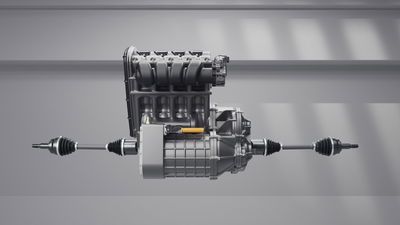Detroit 2009: 2010 Cadillac SRX
Cadillac's largely-ignored midsize SUV, the SRX, is finally getting updated next year, replacing the current SRX that's been in production since 2004.
Cadillac's largely-ignored midsize SUV, the SRX, is finally getting updated next year, replacing the current SRX that's been in production since 2004.
However, this isn't just a new taillights-and-rhinoplasty job: for 2010, the SRX shifts from GM's Sigma platform (shared with the CTS sedan) to a new bespoke platform, which is a combination of Theta (Saturn VUE, Chevrolet Equinox) and Epsilon II (Vauxhall/Opel Insignia). The old SRX was more of a tall station wagon in appearance, but the new one is a fully modern looking midsize crossover, with fully modern underpinnings.
Visually, the new SRX is leaps and bounds more coherent than the old model. The roofline gracefully tapers back towards the end, creating a smooth thick C-pillar, while the angularity of the window frame below provides contrast and a sense of visual strength. I'm not a huge fan of the random cut line running from forward of the front doors through the door handles and upwards into the rear fenders - it's a cheap stylistic trick used to disguise mass and large flat surfaces. Still, it's better than nothing.
The overall profile of the SRX has hints of Saturn VUE (roofline), Equinox (fender vents?), and CTS (headlights, grille, tail lights). Still, even though it looks like it's a bit big for it's shoes, it's much more elegant than the previous SRX:
Under the hood, things get more interesting. The base engine (at least in US-specification cars) is a 3.0L variant of GM's "High Feature" twin-cam V6 family. Destroked to 3.0L from 3.6L, the V6 sports direct fuel injection and in the SRX makes 260 horsepower and 221 lb-ft of torque, which seems entirely adequate for a small SUV.
Upper level SRX's will come equipped with a different variant of the High Feature family, a 2.8L 24v V6 with port injection, and a single twin-scroll turbocharger. This is by and large the same engine that's used in the Saab 9-3 Aero and Turbo X, as well as top-of-the-line Opel Insignias (and the old Vectra VXR.) In the SRX, it makes 300 horsepower and 295 lb-ft of torque. The 3.0L DI V6 is mated to GM's 6T70 automatic, while the 2.8 Turbo V6 is mated to an Aisin-Warner 6 speed automatic.
Also borrowed from Saab is the SRX's all-wheel-drive system, fourth-generation Haldex. This includes the electronic torque-vectoring rear differential that debuted on the Turbo X, which actively sends torque where it needs to go in the rear axle to minimize oversteer/understeer and provide better grip out of corners.
The interior follows the design layout pioneered in the new CTS, and looks quite rich - important in this class of car. One interesting feature is the inclusion of an electronic parking brake (rather than a mechanical one) which frees up space in the footwell (or, I suppose, on the center console.)
Base versions of the SRX will be front wheel drive, naturally. There are rumors of a hybrid version in the pipeline as a variation of this model, which makes sense as the Theta architecture supports it (Vue Greenline Hybrid.)
The new SRX seems set to take a healthy chunk of the small luxury SUV market - or at least what's left of it. Still, better styling, more modern and efficient powertrains, and the sophisticated technology that this segment has come to expect make this seem like a winner to me.













Comments
No comments found.